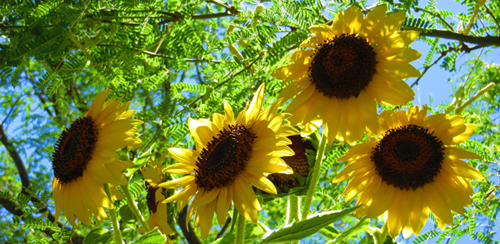Summertime Companion Planting

Sunflowers make great summer garden plants as they provide a source of shade for plants growing beneath them.
photo: Amber Merchant
Spring has officially arrived in Tucson! Warmer than usual temperatures made for an interesting winter growing season. Those that chose to protect last year’s warm season perennials during the few frosty nights we had early in the winter were rewarded with continued harvests into the new year, while many cold-loving crops bolted early due to the above average temperatures. Be sure to take notes in your garden journal about what performed best in your garden this past season, as warmer winter weather is likely in our near future.
One thing we can count on when it comes to Southern Arizona weather is hot summers. Our brutal summer heat is the main barrier for those looking to get started in vegetable gardening and the main culprit responsible for the failures that our region’s gardeners experience. If either of these descriptions fit you, then you may be interested to know that there are many edible crops that actually thrive in our desert heat while at the same time providing a beneficial service to the plants around them.
Organic gardeners know that certain crops benefit when they are grown in close proximity to other plants, a concept known as companion planting—and it comes in many forms. Some plants, such as beans and peas, can actually take nitrogen out of the atmosphere and fix it into the soil into a form that plants can utilize. Other plants, such as aromatic herbs, work well at repelling unwanted pests and attracting beneficial pollinators and predatory wasps that help to keep insect populations in check.
One of the all-around best companions for our desert garden happens to be one of the easiest to grow. So easy, in fact, that it will often sprout up in your garden without you even planting it! I’m speaking, of course, of the fabulous amaranth. Amaranth, sometimes referred to as “pigweed,” is an extremely nutritious crop that is cultivated all over the world as nearly every part of the plant can be put to use. Amaranth is one of the best plants for breaking up tough soil and for pulling nutrients from deep in the soil to the surface, where they can be used by other plants. It’s also an excellent companion to nightshades and it will increase insect resistance in tomatoes. It grows exceptionally well in our desert heat and if allowed to go to seed, you’ll never have to plant it in your garden again.
Okra gets a bad rap as a slimy vegetable that can only taste good when deep fried. This could not be further from the truth. Aside from being an essential ingredient to gumbo, okra is popular in Middle Eastern, African and Caribbean cuisine, and is also used extensively in Mediterranean, Eastern European, and South Asian cooking. As far as heat-lovers go, this relative of the hibiscus is one of the most drought-tolerant crops around and can easily be grown by even the most novice of gardeners. Okra can grow to a height of over six feet in our area so consider planting a few on the south or western sides of your garden to take advantage of the natural shade they’ll create as they grow. Their beautiful trumpet-shaped flowers also work well at attracting pollinators to your garden.
Another heat lover that also works well as a companion to desert vegetable gardens is the majestic sunflower. Native to the Americas, sunflowers provide a valuable food source for birds and pollinators, as well as a source of shade for the plants growing beneath them. While sunflowers can inhibit the growth of some plants, they actually do quite well when grown with cucumbers and work well when planted densely and used as a wind break. Sunflowers are also traditionally included in the “three sisters” garden, sometimes being referred to as the “fourth sister.” Like okra and amaranth, sunflowers planted on the south and west sides of your garden will provide afternoon shade just when your plants will need it the most.
If you’re interested in planting some of these heat lovers in your summer garden, be sure to check out Native Seeds/SEARCH, NativeSeeds.org, as they have an excellent selection of heirloom varieties of the crops discussed above, as well as many other drought tolerant, heat-loving crops that are sure to perform well in your garden this summer.
Brandon Merchant is the proprietor of Southwest Victory Gardens. Visit his website at SouthwestVictoryGardens.com.
Category: Community, FOOD & DRINK, Living




